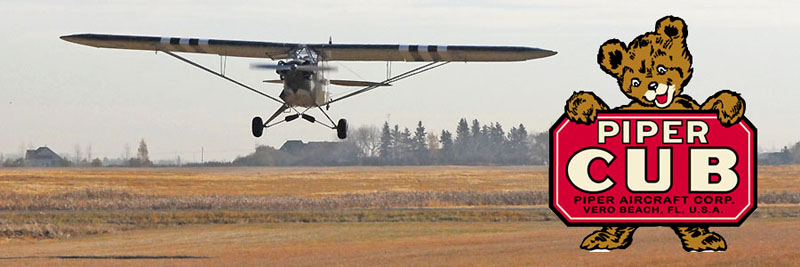
Indus, AB, Canada - October 2013
On October 22, 2013 I had the opportunity to fly my first Piper Cub, courtesy of Ken Lapp. We'd actually been trying to get together for some time, but darn it, I wasn't going to let it pass me by again.

As you can see, there's nothing complicated about a Piper Cub, even when it wears Olive Drab like Ken's. (Trevor McTavish)

Ken has owned this Cub since 1990, when he bought it from its previous owner in Naniamo, BC. Ken brought it to Alberta and had it recovered and painted in military markings. Unlike many quasi-military airplanes, Ken's Cub is a bona-fide combat veteran, having served during the Second World War on Okinawa. (Trevor McTavish)

Since a Cub is all about flying low and slow, we took the opportunity to do some sight-seeing over the Bow River south of Calgary. This summer's floods scoured the river valley - depositing gravel bars and removing acres of soil from the banks. (Trevor McTavish)

But despite the damage below, the mid-October weather was perfect for our flight. Even the cool temperatures helped since we were maxed out on weight. (Trevor McTavish)

One thing a Piper Cub is perfect for is taking pictures of people's farmyards... (Trevor McTavish)

...or their tree growing business and stately home overlooking the river valley. (Trevor McTavish)

The line across the left side of the river in this image is the weir near the Carseland dam. The weir directs water away from the river and into the area's irrigation system. (Trevor McTavish)

Looking out the other window is the town of Carseland. With a population of about 600 people, it's not a big community. You can easily spot the red school in the middle of town. (Trevor McTavish)

A cropped view of Winter's Aire Park (CFY4) as we crossed overhead. This airstrip, with its two 2600' turf runways seems to be inhabited mostly by homebuilt and ultralight aircraft. In this view, we're looking right down runway 28. (Trevor McTavish)

After I managed a couple successful circuits, I climbed out and asked Ken to shoot another circuit so I could get some shots of his Cub flying. I never seem to have problems getting pilots to agree to such requests. (Trevor McTavish)

The great thing about small airports is you can stand beside the runway and take pictures. Try doing that at an international airport. (Trevor McTavish)

In a small plane like the Cub, it was easy to see the effect the loss of 220 pounds (me) has on performance. Ken was airborne in about half the distance and climbing twice as fast. (Trevor McTavish)

Notice the empty front seat. Climbing into the Cub's tight little cockpit was the only real challenge. At 6 feet tall and 220 pounds, there was little room for me to move. (Trevor McTavish)

Despite the tight cockpit, I had a blast. The Cub handles quite well and is nice and light on the controls. You do need to apply rudder to coordinate your turns and I quickly discovered all those years of flying airplanes with inter-connected rudders and ailerons had taught my feet to sleep. (Trevor McTavish)

One thing I will never accuse a Cub of being is fast. Climb out was between 50 and 60mph... (Trevor McTavish)

...and our whole trip was done at about 60 or 65mph. Ken showed me a power-on stall that finally broke at 37 mph. My airplane's airspeed indicator doesn't even start moving until 40mph! (Trevor McTavish)

Landing was simply a case of approaching at 50mph, carrying a touch of power into the flare and letting the Cub settle onto the grass. (Trevor McTavish)

The worst part was that in the front seat, the instrument panel completely blocks your forward vision, leaving you completely blind at touchdown. (Trevor McTavish)

My thanks to Ken for sharing his wonderful little Cub with me. Now I know what someone means when they say, "It flies like a Cub." (Trevor McTavish)